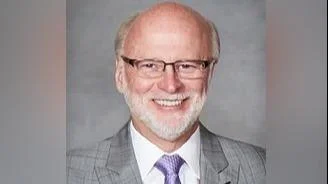OSF OnCall Digital Hospital patient: ‘I felt so connected and safe’ | https://newsroom.osfhealthcare.org/
OSF OnCall Digital Hospital patient: ‘I felt so connected and safe’ | https://newsroom.osfhealthcare.org/
OSF OnCall Digital Hospital patient: ‘I felt so connected and safe’
Most people would rather be in their own bed than in the unfamiliar surroundings of a hospital room and experiencing anxiety that can often come with a hospital stay.
OSF OnCall, the digital arm of OSF HealthCare, launched its Digital Hospital in August. At launch, eligible patients with certain conditions who end up in the Emergency Department at OSF HealthCare Saint Francis Medical Center in Peoria could be admitted to the OSF OnCall Digital Hospital where they receive hospital-level care in the comfort of their own home. Now, OSF OnCall is expanding this care to include patients who have been admitted to a larger variety of OSF Saint Francis inpatient departments, including those transitioning out of ICU, with more continuing to be added. Eligible patients must meet medical, geographic and insurance requirements.
Pam Anderson of Morton was eager to try the Digital Hospital program almost immediately. Anderson works a part-time job at a moving and storage business and lives with her retired husband, Mike. She has chronic obstructive pulmonary disease (COPD) and atrial fibrillation. The day after Thanksgiving, Anderson woke up and was having trouble catching her breath. Her oxygen level had fallen to about 80%. She was sent to the Emergency Department at OSF Saint Francis.
Once she was stabilized and admitted, the next day Anderson was approached about transferring into the Digital Hospital. She was immediately sold. By the time she returned home after discharge, a team had set up the equipment, technology and supplies she needed, including oxygen. An OSF OnCall Mission Partner (employee) walked her through using the equipment. Anderson, who describes herself as not computer literate, says everything was so easy to use.
Easy-to-use technology
“The phone … you don't dial it. You just pick it up and it rings directly to the (digital health) center. And once you do that, then somebody will appear on the iPad. So, if you do need something, you're actually speaking to someone (you can see). You're not just talking on the phone. And, they're extremely prompt in answering. So there really isn't, in my opinion, a lot of technology involved. Thank heavens,” Anderson says with a laugh.
Anderson never had to use that phone in the middle of the night, but she was comforted knowing she could and that she would be instantly connected. Patients also wear a bracelet with a button they can press to be connected immediately to a care team member. Readings Anderson took on her own from a blood pressure cuff or pulse oximeter went directly to caregivers and her electronic health record. Anderson says she felt, “completely connected and safe.”
Her schedule for the day appeared every morning on the tablet, which is provided to individuals admitted to the OSF OnCall Digital Hospital. She laughs about actually looking forward to the twice-daily visits from nurses who checked her medication, took vitals, and made sure she was on the road to recovery, all while smiling and sharing laughs.
“The nurses and aides are absolutely fabulous. They're friendly; they're well informed. They explain everything to you. Always cheerful. I mean I absolutely adored them. I missed them when they were no longer coming.”
Home-delivered meals
Like other patients who’ve been able to qualify for the at-home admission, Anderson says it was great to be home with her three dogs and husband and to have three meals a day delivered right to her door from the hospital kitchen.
“I found the food really good. So yeah, that really worked out nice also. My husband doesn't really know how to cook much. He tries but he's not very good at it. So that was absolutely ideal.”
Anderson says at-home hospital care is easier on family and friends because there’s no need to worry about navigating hospital parking or bad weather. She recalls her in-laws and friends casually stopping by for short visits because it was so easy. And then there’s the ability to sleep so much better – all wins for Anderson who is fully recovered and back at her part-time job.
“I think a lot of times with illness, your frame of mind also helps. And I think this just puts you in a more positive frame of mind and I think you recover sooner. You're more relaxed. You're not worried. ‘When am I going home? When am I going home?’ You're already there!,” Anderson says as she smiles widely.
OSF OnCall Digital Hospital also provides other clinical services typically delivered in a hospital such as physical, speech and occupational therapy and IV infusion services. It helps keep bed space available for those who need it most. That was a lesson reinforced during the peak of the COVID-19 pandemic when hospitals were strained to capacity. Research reveals hospital-at-home programs also reduce hospital readmissions and can reduce care delivery costs by as much as 30%.
OSF OnCall leaders say the goal is to continue to increase the average daily Digital Hospital patient count at OSF Saint Francis, and then expand to other hospitals and medical centers in the OSF HealthCare Ministry.
Original source can be found here





 Alerts Sign-up
Alerts Sign-up